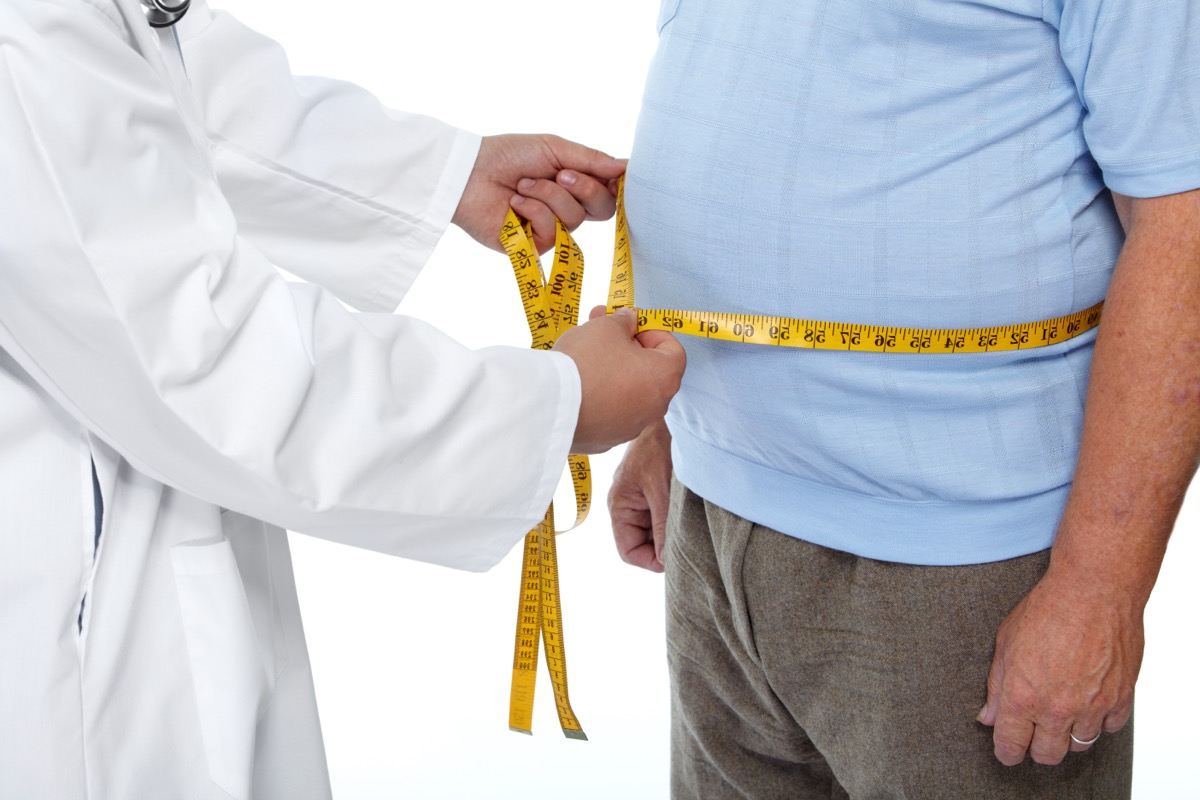I'm a Doctor and Here's How to "Melt" Abdominal Fat Fast

Visceral fat or abdominal fat is a type of fat located deep in your abdomen and surrounds your vital organs. It is not easy to gauge how much visceral fat you might be having by just looking. Visceral fat is not the kind of fat you can pinch. It's the sneaky, nestling kind that wraps itself around our internal organs that we can't even reach or see. That's why we need to give it special attention when trying to lose weight.
Your ability to keep visceral fat at bay may depend on your genes and physical makeup, which means the amount you have isn't entirely in your control. That doesn't mean you can't take steps to manage it better.
If you suffer from abdominal obesity, you may want to get tested for visceral fat. It might be making things more complicated than they need to be — especially if you're struggling to lose weight. Read on to find out more—and to ensure your health and the health of others, don't miss these Sure Signs You've Already Had COVID.
What is Abdominal Fat

According to Harvard Health Publishing, subcutaneous fat around your lower body gives you a pear form, whereas abdominal or visceral fat gives you an apple shape. Abdominal fat is nothing but increased fat around your abdominal organs, increasing the risk of metabolic syndrome and cardiovascular disorder. Hence, it is called active fat.
It's not always considered visceral fat if you have some belly fat. It can be subcutaneous fat stored beneath the skin and can potentially be a source of your belly fat. Subcutaneous fat, which can also be found in the other parts of your body, is more visible. Visceral fat is hidden inside the abdominal cavity and is difficult to detect.
Research says 10% of your body fat is visceral fat. Though visceral fat cannot be measured at home, you can determine your visceral fat by checking your waist-hip ratio. According to a research study, a waist-hip ratio above 0.85 in women and 0.90 in men indicates visceral fat.
Visceral fat can increase the risk of health conditions like;
- Type 2 diabetes
- Cardiac diseases
- Alzheimer's diseases
- High cholesterol
- Increased blood pressure
An unhealthy lifestyle, genetics, hormones, or various medications can be the reason for your abdominal fat. But the good news is it can be reduced by healthy lifestyle habits. Read on to learn the best ways to quickly "melt" abdominal fat.
Intermittent Fasting

Intermittent fasting has gained a lot of attention lately and is believed to be an excellent weight-loss strategy. It's a dietary plan that alternates between eating and fasting intervals. There are various types of intermittent fasting that you can follow based on your lifestyle and eating habits.
The best way to lose visceral fat is by adapting to a healthy diet and following intermittent fasting. A recent 2022 study supports this claim and has demonstrated that people can lose weight, especially visceral fat by following intermittent fasting.
Leptin hormone aids in weight management by regulating food intake and energy expenditure by altering signals to the hypothalamus and other brain areas. Because of its moderate energy restriction, intermittent fasting has been shown to help reduce fat, particularly in the belly and trunk. The hormone leptin/adiponectin may improve as a result of the weight loss, and this may help you control your appetite.
As a result, incorporating intermittent fasting into your daily routine can help you lose belly fat.
Aerobic Exercise

Aerobic exercise raises peak oxygen consumption, which is linked to total body fat percentage; it is also an effective weight-reduction method, particularly for belly fat loss.
Practicing moderate aerobic exercise of 150 minutes per week is thought to help lower the risk factors linked to metabolic syndrome. A 12-week study conducted on people who did aerobic exercise found that exercise helped them lose weight even when they didn't track their calories.
If you are overweight and want to lose weight and minimize abdominal fat, you should go for high-intensity aerobic exercise.
Some simple and effective aerobic exercises to reduce abdominal fat are;
- Brisk walking
- Cycling
- Running
- Swimming
- Light jogging
Adding these exercise routines not only helps you lose belly fat but also improves your overall health.
Stress Management

It has been observed that people with high-stress levels and who have poor coping skills most commonly experience abdominal fat. Cortisol secretion could explain the link between stress and belly fat distribution. Abdominal obesity can be the result of psychological stress and increased cortisol release, which in turn causes belly fat over time.
Mindfulness training can help you overcome overeating tendencies and reduce the cortisol awakening response, which may lead to a reduction in belly fat over time. Look for ways to unwind if you're under a lot of stress at work or elsewhere. Yoga, meditation, and mindfulness are just a few examples of strategies to stay calm.
Quit Smoking

An analysis published in the BMJ Open Journal clearly indicated that smoking leads to increased belly fat. People commonly believe that quitting their smoking habit causes weight gain. This is true because smoking suppresses hunger, and quitting causes an increase in appetite and weight gain. However, this is only a transient effect; after a few weeks, your body adapts, and you begin to reap the benefits.
When you quit smoking, it brings significant improvement in your metabolic health, which results in weight loss. Quitting also reduces the risk of health complications, reduces your anxiety levels, and improves mental health. Hence, If you want to lose belly fat, along with diet changes and exercise routine, make sure you quit smoking.
Diet Modifications

Certain nutritional modifications can also help you achieve a flat belly;
- Avoid consumption of sugar and sweetened beverages. Consuming more sugar-sweetened drinks is linked to abnormal visceral fat accumulation.
- Follow a low-carb diet. Cutting carbs is particularly beneficial in improving body composition, fat distribution, and glucose metabolism.
- Incorporate more protein in your diet. This can help you lose visceral fat by increasing your metabolism and decreasing your appetite.
- Plan your meals ahead. Following a low-carb, high-protein diet alone may not be enough; keep track of your meals and plan ahead to practice mindful eating.
Last Word From Doctor

Visceral fat is connected to a number of health issues. Important lifestyle adjustments, on the other hand, can help you shed stubborn belly fat and live a healthy life. I've included the four most effective techniques to lose visceral fat. If you only do that, you will undoubtedly see results. And to protect your life and the lives of others, don't visit any of these 35 Places You're Most Likely to Catch COVID.
Dr. Rashmi Byakodi is a writer who helps her readers live healthier and happier lives.








